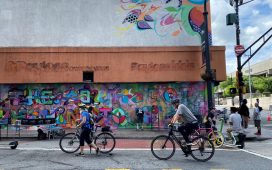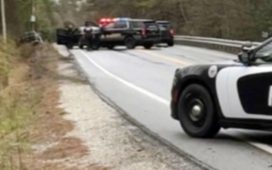For the past nine years, the Seattle Department of Transportation (SDOT) has relied on a $930 million property-tax levy to pay for about 30% of its budget. That levy expires at the end of 2024. In November, Seattle voters will be asked to renew it for $1.45 billion over eight years.
For the owner of a median-valued $804,000 Seattle home, the expiring transportation levy costs $276 annually. The $1.45 billion renewal would increase that to $468 a year. Owners of rental units would also see their taxes go up, which they would likely pass along to renters.
Though that would make it the largest levy in Seattle’s history, a coalition of street safety and climate advocates are pressing the City Council to increase the tax to pay for more sidewalks, bike lanes, dedicated bus lanes and crosswalks. The coalition includes Disability Rights Washington, Seattle Neighborhood Greenways, Transit Riders Union, 350 Seattle, Puget Sound Sage, Seattle Subway and more.
Mayor Bruce Harrell and SDOT released their final proposal for the transportation levy on May 3. After initially proposing a $1.35 billion levy in April, Harrell added $100 million to the price tag to pay for sidewalks, bicycle and pedestrian connections to light-rail stations, bus lanes and other projects in response to the request for more.
On May 7, the City Council began its work on the proposed tax.
“The work we do here in this committee will be some of the most impactful work any of us do in our entire time on the Council,” said Councilmember Rob Saka, chair of the Transportation Levy Committee, at its May 7 meeting. “It’s an opportunity that comes just once a decade to build a better future for Seattle.”
In his opening remarks, Saka discussed the huge swath of work the levy touches, from keeping Seattle’s aging bridges in good repair to reshaping Downtown’s Third Avenue for a post-pandemic world. But mostly he focused on safety implications.
“This transportation levy is about making our roads safe for everyone and allowing people to better connect in our neighborhoods no matter whether they are walking, biking, rolling, driving or using transit,” said Saka.
The majority of the more-than-two dozen public commenters at the committee meeting asked the Councilmembers to do more for pedestrians, bicyclists and transit riders in order to meet Seattle’s Vision Zero and climate goals. Seattle and Washington share a goal of reaching zero traffic fatalities or serious injuries, but are nowhere near accomplishing it.
And about 61% of Seattle’s annual carbon emissions come from transportation, meaning reaching climate goals will require getting people out of their cars.
In her testimony, Rita Hulsman illustrated the stakes of getting road safety right. Her husband Steve was hit and killed by a driver while biking in West Seattle last December.
“Four days before Christmas, Steve became a Seattle traffic fatality statistic, but he was so much more than a statistic to me,” said Hulsman, fighting back tears. “He was a loving dad to our three kids and grandpa to our young grandson. He was also a much-loved brother, uncle, friend and my husband of over 40 years. We would’ve celebrated our 42nd anniversary tomorrow. Please don’t let this happen to anyone else. Please fund Vision Zero and safety well.”
The proposed transportation levy would provide $114 million for bicycle safety projects, $135 million for pedestrian projects and $162 million for Vision Zero, school and neighborhood safety projects. It also would provide $423 million for street repaving projects, which would include bike and pedestrian safety elements. For example, when a street undergoes a full repaving, it can get new bike lanes and additional crosswalks.
But advocates argue even a nine-figure investment will be insufficient to move the needle on pedestrian and bicyclist safety. For example, with the current proposed funding levels, SDOT will build 280 blocks of new sidewalks, 250 of which would come in the levy’s first four years. But the city is missing well over 10,000 blocks of sidewalks.
“The challenge of the 13,000 missing blocks of sidewalks is really, really significant and beyond the ability of one levy to address,” said Meghan Shepard, SDOT’s deputy director of Downtown mobility, in a presentation to the Council. “But we can take some firm steps forward in looking at this. And one of them is the proposed sidewalk surge to deliver 250 blocks in four years.”
Shepard said SDOT was also forming a work group to seek outside grants and funding that could help build additional blocks of sidewalks after those first four years.
The coalition of advocates is asking Councilmembers to increase the levy to around $1.9 billion. Polling data from Change Research shows Seattleites might support it. The online poll of more than 600 likely Seattle voters was commissioned by the Northwest Progressive Institute in partnership with the street safety coalition.
Asked about renewing the levy at its current funding levels, 71% of respondents were supportive, 41% strongly supportive and 31% somewhat supportive. Voters’ top priorities were to repair bridges and repave streets in poor condition, followed closely by improving safety on Seattle’s most dangerous streets, building sidewalks where they are missing, and investing in improvements to help kids walk and bike to school safely.
Asked to choose between increasing the levy price tag to $1.7 billion or $1.9 billion and hearing an explanation of what the additional money could pay for, 54% of respondents said they preferred the $1.9 billion option. Another 25% said they preferred the $1.7 billion option, while 21% said they opposed renewing the levy. The poll had a margin of error of 4.1%.
At the May 7 Council meeting, Saka acknowledged the call for increasing the size of the levy, and said that he’d read the coalition’s February letter calling for a $3 billion levy renewal. But he signaled a reluctance to do so.
“Even if we had a $3 billion levy it wouldn’t meet the need. We’re unlikely to meet the total need at whatever size,” Saka said. “But what we do need is a plan and a strategy to meet the needs.”









